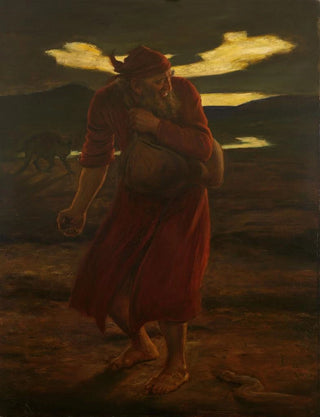Art print | The Parable of the Tares - Sir John Everett Millais


View from behind

Frame (optional)
In the rich and complex universe of Pre-Raphaelite art, "The Parable of the Weeds" by Sir John Everett Millais stands out for its narrative depth and flamboyant aesthetics. This artwork, painted in 1863, depicts a biblical scene that is both timeless and poignant, where the struggle between good and evil unfolds under the watchful eye of a benevolent Christ. Millais, with his technical skill and keen eye for detail, manages to capture the very essence of this parable, offering viewers an immersive experience in a visual story laden with symbolism. The light, colors, and expressions of the characters combine to create an atmosphere that is both serene and unsettling, inviting reflection on human nature.
Style and uniqueness of the work
Millais's style in "The Parable of the Weeds" is emblematic of the Pre-Raphaelite approach, which favors realism and the expression of emotions through meticulous detail. Every element of the canvas, from faces to landscapes, is carefully crafted, demonstrating attentive observation of nature and the human condition. The use of vivid colors and striking contrasts enhances the visual impact of the piece, while the balanced and harmonious composition guides the viewer’s gaze through the scene. The presence of the weeds, symbolizing evil and sin, contrasts with the serene figure of Christ, embodying hope and redemption. This play of light and shadow, both literally and metaphorically, gives the work a depth that transcends the simple narrative to touch on universal truths.
The artist and his influence
Sir John Everett Millais, co-founder of the Pre-Raphaelite movement, marked his era with a bold and innovative artistic vision. His commitment to depicting subjects from literature, mythology, and religion, while incorporating a naturalist approach, opened new avenues in 19th-century British art. Millais was not content to reproduce reality; he sought

Matte finish

View from behind

Frame (optional)
In the rich and complex universe of Pre-Raphaelite art, "The Parable of the Weeds" by Sir John Everett Millais stands out for its narrative depth and flamboyant aesthetics. This artwork, painted in 1863, depicts a biblical scene that is both timeless and poignant, where the struggle between good and evil unfolds under the watchful eye of a benevolent Christ. Millais, with his technical skill and keen eye for detail, manages to capture the very essence of this parable, offering viewers an immersive experience in a visual story laden with symbolism. The light, colors, and expressions of the characters combine to create an atmosphere that is both serene and unsettling, inviting reflection on human nature.
Style and uniqueness of the work
Millais's style in "The Parable of the Weeds" is emblematic of the Pre-Raphaelite approach, which favors realism and the expression of emotions through meticulous detail. Every element of the canvas, from faces to landscapes, is carefully crafted, demonstrating attentive observation of nature and the human condition. The use of vivid colors and striking contrasts enhances the visual impact of the piece, while the balanced and harmonious composition guides the viewer’s gaze through the scene. The presence of the weeds, symbolizing evil and sin, contrasts with the serene figure of Christ, embodying hope and redemption. This play of light and shadow, both literally and metaphorically, gives the work a depth that transcends the simple narrative to touch on universal truths.
The artist and his influence
Sir John Everett Millais, co-founder of the Pre-Raphaelite movement, marked his era with a bold and innovative artistic vision. His commitment to depicting subjects from literature, mythology, and religion, while incorporating a naturalist approach, opened new avenues in 19th-century British art. Millais was not content to reproduce reality; he sought






